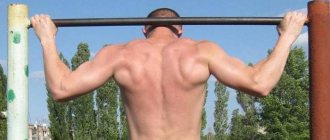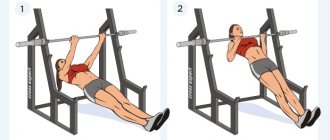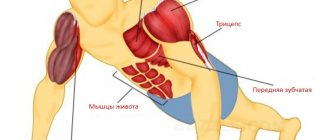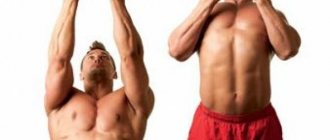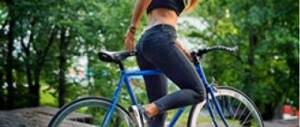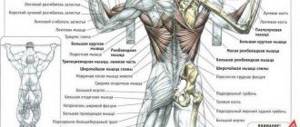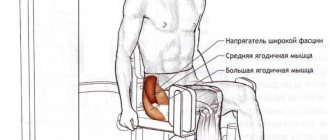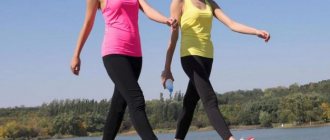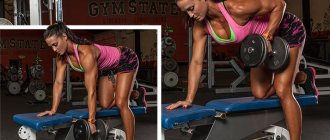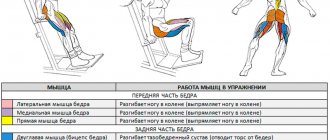Push-ups are a popular and practical form of training the muscles of the chest, abs, deltas and triceps. At school, physical education teachers often resorted to this exercise. Of course, it was not by chance and not out of a desire to satiate his sense of self-importance by reveling in power over the kids. Young bodies that are still fragile (as well as the flabby bodies of office clerks) need to train several muscle groups at once. In the absence of the opportunity to conduct physical education lessons every day, teachers are forced to resort to a difficult but effective method for the rapid development of the muscular system - push-ups. Let's look at basic exercises for different muscle groups, which are a springboard into the world of a chiseled figure and admiring female looks.
A journey of a thousand miles begins with the first step. In our case, the path to an ideal and athletic figure begins with the simplest basic exercises.
Basic position – body parallel to the floor, hands shoulder-width apart
A parting word about the benefits for the body
Even a person far from sports knows that proper physical activity has benefits for the body. Fit figures attract the attention of the opposite sex, sports reduce the likelihood of hypertension and heart attack, and delay the onset of many diseases. In general terms, floor presses benefit the entire body, especially the cardiovascular system.
Are you planning to take up martial arts? Floor presses should definitely be included in your individual training regimen. It is push-ups that strengthen the hands, especially if the exercise is performed with fists. With systematic practice of all types of push-ups, the muscles of the chest, back and abs, deltoid muscles of the shoulders, calf and intercostal muscles develop. There is also a positive effect on the spine, which is in dire need of a strong muscle corset.
Systematic push-ups develop an entire muscle group
Floor presses can have the opposite effect if performed incorrectly. For example, you definitely shouldn’t start training with additional weight loads right away. First, you need to learn how to perform the basic floor press, which your school physical education teacher so persistently suggested mastering.
Push ups
How to pump up your back with push-ups. No way! During push-ups, the back rests calmly, while the chest muscles “plow”. The wider the position of the hands, the better they are loaded. The deltoid muscles also do not sleep, they help push the body upward. The main function of the triceps is to extend the arm. And this is what happens during push-ups. So it works too. The narrower the hands, the better the triceps “burn.” The ulnar muscle, which extends the forearm, also “sweats.” So no matter how you twist it, you won’t shake your back with push-ups.
So, the basic exercises in the sports operation “how to pump up your back at home” - pull-ups on the horizontal bar and on the uneven bars - come out on top. With such simple at first glance, but functional movements, muscle fibers throughout the body work to their maximum. Moreover, having learned how to do pull-ups, you can then impress your friends with various tricks on the horizontal bar. These exercises are ideal for how to pump up your back muscles at home. So, the topic of bodybuilding with exercises was closed. Choose your right weights, listen to your body. Although training is good, it is only 40% of the success in creating the body of your dreams. A significant part of success depends on the products that are on your plate every day. Nutrition, like workouts, depends on your body type. There are 3 basic body types: ectomorph, mesomorph and endomorph. To understand who is who and what type you are, do a simple test. Measure your wrist circumference. A volume of 15 to 17.5 cm indicates a thin type, that is, an ectomorph. From 17.5 to 20 cm is an average build, that is, mesomorph. Above 20 cm – large build, that is, endomorph. All body types have disadvantages when it comes to building a muscular body, but all body types have advantages. It remains to wish you that you turn your disadvantages into advantages.
Basic technique
Before starting classes, you need to warm up. Rules for the classic push-up technique:
- Lying emphasis. Hands are slightly wider than shoulders.
- The back should be straight. The entire spine, from the neck to the lower back, should look like a straight, stretched string.
- The abdominal muscles should be slightly tense.
- The legs are slightly spread and raised on the toes.
- Hands bend at the elbows as you inhale. Important! The back should remain straight; bending the spine is not recommended.
- There is no need to lower your chest all the way to the floor. There should be a few centimeters between the floor and the body.
- The body returns to its original position as you exhale.
The basic technique will prepare the muscles of the back, deltas, abs and chest for their focused training. Also, classic push-ups train coordination, which is important for further training.
To train the upper chest, you need to place your feet on an elevated surface.
Second
The second type of exercises are pulls performed in the plane of the body or perpendicular to the body, only with the elbows raised high. In such conditions, you work the upper segment of the back. The second type of exercise also includes pull-ups, various deltoid flyes for the rhomboid muscles, and deadlifts. This group includes movements that will make your dream come true, like pumping up your back on horizontal bars if the road to the gym is closed. Pull-ups are a very functional exercise. It pumps up not only the back. The abs and arms also receive stress. If you grab the crossbar with a medium grip and point your palms toward you, you can use your biceps.
We almost forgot about the extensor muscles. They can be strengthened with regular and reverse hyperextensions, as well as with the “good morning” exercise. Do not neglect such training, because with the help of these muscles the density of the back increases. We’re done with non-home exercises, let’s move on to how to pump up your back at home. It has already been said that a horizontal bar is ideal for home training. And, of course, bars. Thanks to one exercise on this equipment, you will forget about the problem of how to pump up your back on the uneven bars. You need to do pull-ups on the uneven bars like this: hang on the bars parallel to them, grasping with your hands and clinging to your feet. And begin to pull yourself up, pulling your chest to the level of the parallel bars. If for basic exercises the number of repetitions remains classic - 8-12, then for pull-ups Denis Semenikhin, a fitness guru who published a book and lives in America, for example, recommends doing as many repetitions as you can in 5 minutes. For example, in 5 minutes 50 times. Of course, you can wave your hand until you see his super toned back. There is another chance to pump up the latissimus dorsi muscles at home. If you may not have dumbbells, then perhaps you have a gymnastic band or expander. You tie this springy equipment to a chair, bend over and begin to pull the tape towards you with one hand.
Pectoral muscle training
In order to focus your efforts directly on the chest muscles when doing push-ups, you must remember the following rules:
- The floor press technique should involve bringing your shoulder blades together. Only when this condition is met are the corresponding muscle groups activated.
- When lying down, your arms should be spread wide apart. In this case, to raise the body, you will need not only to straighten your elbows, but also to bring your shoulder blades together.
- To work the middle part of the chest, your legs and arms should remain on the floor, your body parallel to the floor. Thus, for exercises targeting the mid-chest, elevation is not required.
- The upper chest will be worked by placing your feet elevated, but not too high. The height of the gymnastic bench will be ideal.
- The lower chest will be engaged when placing the arms in an elevated position. The same principle works here as with the upper pectoral muscles. Hands should not be placed too high.
An alternative to the gymnastics bench is push-ups on parallel bars. In this case, your feet should not touch the floor. To effectively stretch the pectoral muscles, you need to use stable supports on which you can place your hands. This will allow the body to be lowered. Horizontal bars in the yard are quite suitable.
To train the lower chest, you need to place your hands on an elevation
First
The latissimus muscles are responsible for how to pump up a wide back. People call the lats “wings” because they form the coveted inverted triangle. These are the second largest muscles in the body and lend themselves to serious training. How to pump up the latissimus dorsi muscles? To answer the sports question, you need to look at the functions of the “wings”. With the help of the latissimus muscles, the arm is pulled back, and also makes it possible to pull the arm towards the body. You can pump up the center of the back and muscles with various pulls performed perpendicular to the axis of the body, with the arms close to the body. Please note: when performing seated rows in a triangle machine, with a narrow grip, the deep muscles of the latissimus are activated, closer to the spine, and with a wide grip, the outer muscles are activated. By the way, it is the narrow grip that will help you learn how to pump up your lower back.
This type of exercise can easily include one-arm bent-over rows. It is this method that will not raise any questions in your mind if you ask: “How to pump up your back with dumbbells.” This exercise will help pump up the latissimus dorsi muscles with dumbbells, not equipment. This means that you already know one exercise from the arsenal of how to pump up the latissimus muscles at home. You need to pump not only the “wings”, but also the trapezius muscles. An exercise from the first type is a pull-down of the lower block with a narrow grip. A triangle is often used for this. The trapezius is also well used by pulling the rope from above to the face.
Triceps workout
A little physiology. Triceps (triceps muscle) is the back muscle of the humerus, thanks to which the elbow flexes and extends. When doing push-ups, it always works, however... This muscle is small in size, so the load on it is distributed among other muscle groups. To maximize the involvement of the triceps muscle, it is necessary:
- Minimize the work of the pectoral muscles. Reduction of the shoulder blades is excluded.
- Use correct hand placement. It is better to place your palms shoulder-width apart. In this case, the elbows will be pulled back and located along the body.
- Practice reverse push-ups. You will need a gymnastic bench or any other similar support, with your arms behind your back.
When working on the triceps, it is important to remember that this muscle will work during the floor press only in the absence of contraction of the shoulder blades. In this case, the body will rise not with the help of the pectoral muscles, but solely due to the extension and flexion of the elbows.
When training triceps, it is important to avoid retraction of the shoulder blades.
Warming up the muscles
Before doing push-ups, you need to warm up your back and shoulder muscles. Do the following set of exercises:
- Grab your head with your right hand and slowly pull it until it touches your shoulder.
- Find a vertical support (door frame, pole, or ask your girlfriend or wife for help), grab it and lean back. At the same time, try to straighten your legs. Freeze for 3-5 seconds, then repeat the exercise with the other hand.
- To stretch your triceps, place one hand behind your neck and pull it with the other. Don't move for 3-5 seconds, then repeat the exercise with the other hand.
- Align yourself and pull the elbow of one arm with the other for 10-15 seconds. At the same time, pay attention to the shoulder: it should be at a right angle to the floor.
- Place your feet shoulder-width apart. Raise your arms and turn your body to the sides. You need to do 8-10 repetitions.
On the subject: Back muscles exercise complexes
Now your muscles are ready for push-ups.
Ballistic exercises and crossfit
Push-ups help strengthen your hands and prepare them for striking a punching bag or sparring partner. It is possible to begin the steepest and, at the same time, the most traumatic types of push-ups, in which the backs of the hands, fists and fingers are used as support, only after a detailed study of all the above muscle groups.
Explosive Strength Development
Plyometric (also called “ballistic” or “explosive”) exercises allow you to ensure maximum muscle work in a minimum amount of time. A must have for athletes who consider themselves to be “advanced”. They include two basic types of push-ups:
- Floor presses with hand clapping. The good old “Spartan” floor press. Both hands are shoulder-width apart, one hand is slightly in front of the other. When doing push-ups after clapping, the position of the hands changes.
- Burpee (burpee) refers to the abolition of the CrossFit system, the algorithm of which looks like this: squat, palms on the floor in front of you; with a push, the legs are straightened, the body is parallel to the floor in a press position; push-ups; return to squat; jumping with arms stretched upward; return to the starting position.
All push-ups aimed at developing explosive strength are performed at high speed, without pauses and with maximum muscle work in their positive and negative phases.
Clapping push-ups are important to perform at high speed.
Stimulating muscle growth
To stimulate muscle growth, you need to use additional load in the form of weight when doing presses. It could be a barbell, a heavy backpack, a weighted vest, or a girl. In this case, it is recommended to perform push-ups with both wide and narrow arms positioned alternately.
Approaches and push-ups in numbers
The number of approaches and presses depends entirely on your training goals. Where to start:
- If you need to burn fat deposits and gain relief - from 10 to 25 push-ups, 4 sets.
- If you need to stimulate the growth of the pectoral, shoulder and upper back muscles - from 8 to 13 push-ups in 4 sets.
Then we gradually increase the numbers. The guideline is to practice to the limit of what is possible, but not to the detriment. If after or during exercise you experience discomfort, unpleasant sensations or pain, and you have to make a volitional effort to continue exercising, the chosen training regimen is most likely not suitable and should be reconsidered.
Push-ups on parallel bars - an alternative to the gymnastic bench
If you are unable to develop a training regimen on your own, the most reasonable solution is not to experiment with your own body, but to turn to a professional. Even one meaningful lesson from a trainer will give more than several training sessions “by touch”.
